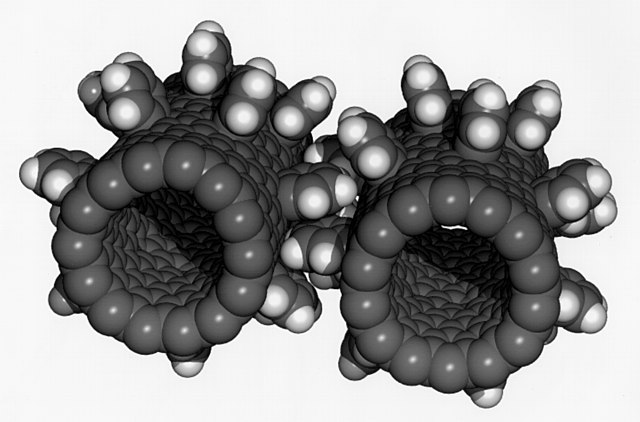
How small is nanotechnology? It is between 1 and 100 nanometers.
1 nanometer is 0.000001 mm. It is hard to imagine how small that is. A human hair is about 0.1 mm wide, which makes it 100,000 nm. Nanotechnology is between a thousand and a hundred thousand times smaller than the width of a hair.
What is nanotechnology? It is where complicated structures are made from molecules or atoms. It isn’t a case of just trying to make something as small as possible. Objects are made out of a few atoms precisely because of what they can do. There are several benefits of working at the atomic scale because of the properties that nanoobjects possess. Materials behave very differently on the nanoscale than they do when they are much larger.
One of the most important properties is the change in their surface area to their volume. The smaller an object is, the larger surface area to volume it will have. If you have a cube with dimensions that are all 2 cm, it has a volume of 8 cm3 and a surface area of 24 cm2, which is a ratio of 3:1. If you have a cube with dimensions that are all 1 cm, it has a volume of 1 cm3 and a surface area of 6 cm2, which gives a ration of 6:1. The smaller cube has a larger surface area to volume ratio. As the cube gets smaller, the surface area to volume ratio increases. This is one of the main reasons why nanotechnology is so useful. If an object has a large surface area, it is more exposed to the surrounding environment, allowing it to take in chemicals more quickly, speeding up chemical reactions. This is important when they are used as catalysts to clean gases or liquids. It also makes nanotechnology very strong because the large surface area means the atoms are in more contact with other atoms.
Nanotechnology has other properties as well because physics work differently at the atomic level. Colors can change because the objects are so small, they reflect light differently. Gold is obviously gold colored, but if you take gold atoms and arrange them, it can be dark red or purple. Their conductivity and reactivity change as well. This is also down to their large surface areas.
Graphene is a good example of nanotechnology. It is made of a single layer of carbon atoms. These atoms can then be rolled into a carbon tube to make them even stronger. Graphene in a tube is harder than diamond but more flexible than rubber. It is 200 times stronger than steel but far lighter than paper. The potential for such a material is incredible. It could make so many different technologies possible. It might even make a space elevator possible.
How is nanotechnology made? The first step is being able to see it. Electron microscopes are too expensive and require too much preparation time. In the 1980s, the scanning tunneling microscope (STM) and the atomic force microscope (AFM) were both invented and they made nanotechnology possible. The AFM works by using atomic force. The tip of the AFM is only a few nanometers in diameter, and it is supported on a cantilever. When it is used to scan nanotechnology, the atomic forces in the atoms of the nanotechnology move the tip of the microscope up and down, and the computer can translate this into an image. The STM has one single atom on its tip. It works by sending an electric signal to the atom being scanned. The tip of the STM is also free to move and it moves up and down to keep the electric signal and the distance constant. The computer can translate this into an image as well. Thanks to these, scientists can see individual atoms and they can move the atoms to create structures out of them.
Nanotechnology is going to be so important in so many parts of our lives in the future. It will make materials stronger and lighter. It can be used to clean the pollutants out of water, and it could be used to take the salt out of water. They can even be used in foods. The large surface area of nanotechnology could make mayonnaise more spreadable. Possibly one of the most important areas they will make an impact is in electronics. Microchips made of silicon are rapidly approaching their limit. If graphene can be used instead, the chips can become smaller, faster, and probably cheaper as well. Nanotechnology is going to transform our lives in so many ways. And this is what I learned today.
Sources
https://www.news-medical.net/life-sciences/Properties-of-Nanoparticles.aspx
https://education.nationalgeographic.org/resource/nanotechnology/
https://www.nano.gov/nanotech-101/what/nano-size
https://www.nano.gov/about-nanotechnology/working-at-nanoscale
https://www.twi-global.com/technical-knowledge/faqs/what-are-nanoparticles
https://www.azonano.com/article.aspx?ArticleID=1134
